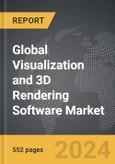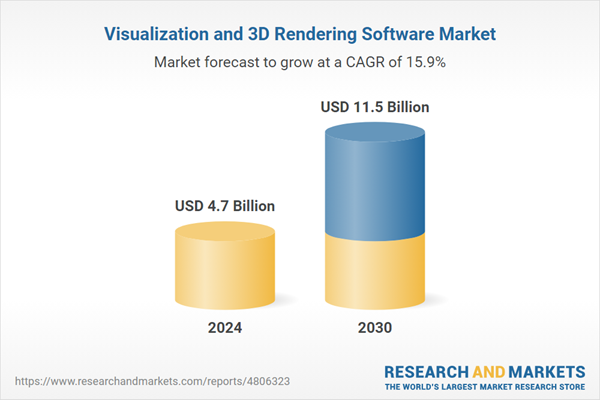Global Visualization and 3D Rendering Software Market - Key Trends & Drivers Summarized
What Is Visualization and 3D Rendering Software, and Why Is It Transformative?
Visualization and 3D rendering software is a technology that allows designers, architects, and developers to create graphical content and visual effects for a wide range of applications including video games, architecture, simulators, and virtual reality. This software enables the conversion of 3D models into understandable and accessible visual formats, providing a realistic representation of objects before they are physically built or produced. The power of visualization and 3D rendering lies in its ability to give life to ideas and concepts, greatly enhancing communication, improving design and conceptualization, and helping to sell ideas and products through more engaging visuals. It serves as a crucial tool in industries where design precision and visual aesthetics are paramount, significantly reducing costs and time by identifying design issues before construction or manufacturing begins.How Is Technology Advancing in the Field of Visualization and 3D Rendering?
Technological advancements are dramatically shaping the capabilities of visualization and 3D rendering software. The introduction of more powerful computing hardware and advancements in graphics processing technologies have allowed these software applications to produce more detailed and complex images at higher speeds. Furthermore, the integration of artificial intelligence and machine learning has begun to automate some of the most time-consuming aspects of the rendering process, such as lighting and texturing, which can now be optimized based on the software's 'learned' preferences from a vast database of images. Cloud computing has also made high-end rendering more accessible to a broader range of users, providing the necessary computing power on demand without the need for expensive on-site equipment.Who Uses Visualization and 3D Rendering Software?
The use of visualization and 3D rendering software spans across multiple industries. Architects and real estate developers utilize it to create detailed depictions of buildings and interior spaces, helping clients to visualize their investments before any real construction takes place. In the entertainment industry, particularly in filmmaking and video game development, artists rely on these tools to create detailed and immersive worlds. Additionally, automotive engineers use 3D rendering to prototype new vehicle designs digitally, testing aesthetics and functionalities before the manufacturing process begins. Even educators and trainers are finding value in 3D rendered visualizations, using them to create more interactive and engaging learning environments, especially in scientific and technical education.Growth in the Visualization and 3D Rendering Software Market Is Driven by Several Factors
The growth in the visualization and 3D rendering software market is driven by several factors, including the increasing demand for realistic animation and rendering solutions from the media, entertainment, and advertising sectors. There is also a significant rise in the use of this technology in architectural and product design, spurred by the growing real estate and automotive sectors. Moreover, advancements in technology and integration with cloud-based services have expanded the accessibility of powerful rendering tools, allowing small firms and individuals to produce high-quality renders without significant hardware investments. Additionally, the trend towards virtual reality and augmented reality in consumer applications is pushing developers to create more sophisticated and realistic models and environments, further stimulating market growth. Consumer behavior that favors more detailed and interactive visual content has also played a crucial role in adopting these advanced technologies.Report Scope
The report analyzes the Visualization and 3D Rendering Software market, presented in terms of market value (USD). The analysis covers the key segments and geographic regions outlined below.- Segments: Product (Standalone, Plugin); Deployment (Cloud, On-Premise); Vertical (Construction & Real Estate, Media & Entertainment, Healthcare & Life Science, Energy & Utilities, Education, Other Verticals).
- Geographic Regions/Countries: World; USA; Canada; Japan; China; Europe; France; Germany; Italy; UK; Rest of Europe; Asia-Pacific; Rest of World.
Key Insights:
- Market Growth: Understand the significant growth trajectory of the Standalone Software segment, which is expected to reach US$8 Billion by 2030 with a CAGR of 16.6%. The Plugin Software segment is also set to grow at 14.3% CAGR over the analysis period.
- Regional Analysis: Gain insights into the U.S. market, valued at $1.3 Billion in 2024, and China, forecasted to grow at an impressive 20.5% CAGR to reach $2.1 Billion by 2030. Discover growth trends in other key regions, including Japan, Canada, Germany, and the Asia-Pacific.
Why You Should Buy This Report:
- Detailed Market Analysis: Access a thorough analysis of the Global Visualization and 3D Rendering Software Market, covering all major geographic regions and market segments.
- Competitive Insights: Get an overview of the competitive landscape, including the market presence of major players across different geographies.
- Future Trends and Drivers: Understand the key trends and drivers shaping the future of the Global Visualization and 3D Rendering Software Market.
- Actionable Insights: Benefit from actionable insights that can help you identify new revenue opportunities and make strategic business decisions.
Key Questions Answered:
- How is the Global Visualization and 3D Rendering Software Market expected to evolve by 2030?
- What are the main drivers and restraints affecting the market?
- Which market segments will grow the most over the forecast period?
- How will market shares for different regions and segments change by 2030?
- Who are the leading players in the market, and what are their prospects?
Report Features:
- Comprehensive Market Data: Independent analysis of annual sales and market forecasts in US$ Million from 2024 to 2030.
- In-Depth Regional Analysis: Detailed insights into key markets, including the U.S., China, Japan, Canada, Europe, Asia-Pacific, Latin America, Middle East, and Africa.
- Company Profiles: Coverage of players such as Adobe Inc., Autodesk, Inc., ANSYS, Inc., Bentley Systems, Inc., Augment and more.
- Complimentary Updates: Receive free report updates for one year to keep you informed of the latest market developments.
Some of the 184 companies featured in this Visualization and 3D Rendering Software market report include:
- Adobe Inc.
- Autodesk, Inc.
- ANSYS, Inc.
- Bentley Systems, Inc.
- Augment
- Advanced Science and Automation
- Analist Group s.r.l.
- 20-20 Technologies, Inc.
- 3d Power Visualization
- ARKTEK3D
- 3d Rendering China
- Avataar.Me
- Archdraw Outsourcing
- BIMEX Engineers
- Abvent
This edition integrates the latest global trade and economic shifts into comprehensive market analysis. Key updates include:
- Tariff and Trade Impact: Insights into global tariff negotiations across 180+ countries, with analysis of supply chain turbulence, sourcing disruptions, and geographic realignment. Special focus on 2025 as a pivotal year for trade tensions, including updated perspectives on the Trump-era tariffs.
- Adjusted Forecasts and Analytics: Revised global and regional market forecasts through 2030, incorporating tariff effects, economic uncertainty, and structural changes in globalization. Includes historical analysis from 2015 to 2023.
- Strategic Market Dynamics: Evaluation of revised market prospects, regional outlooks, and key economic indicators such as population and urbanization trends.
- Innovation & Technology Trends: Latest developments in product and process innovation, emerging technologies, and key industry drivers shaping the competitive landscape.
- Competitive Intelligence: Updated global market share estimates for 2025, competitive positioning of major players (Strong/Active/Niche/Trivial), and refined focus on leading global brands and core players.
- Expert Insight & Commentary: Strategic analysis from economists, trade experts, and domain specialists to contextualize market shifts and identify emerging opportunities.
Table of Contents
Companies Mentioned (Partial List)
A selection of companies mentioned in this report includes, but is not limited to:
- Adobe Inc.
- Autodesk, Inc.
- ANSYS, Inc.
- Bentley Systems, Inc.
- Augment
- Advanced Science and Automation
- Analist Group s.r.l.
- 20-20 Technologies, Inc.
- 3d Power Visualization
- ARKTEK3D
- 3d Rendering China
- Avataar.Me
- Archdraw Outsourcing
- BIMEX Engineers
- Abvent
Table Information
| Report Attribute | Details |
|---|---|
| No. of Pages | 552 |
| Published | December 2025 |
| Forecast Period | 2024 - 2030 |
| Estimated Market Value ( USD | $ 4.7 Billion |
| Forecasted Market Value ( USD | $ 11.5 Billion |
| Compound Annual Growth Rate | 15.9% |
| Regions Covered | Global |









